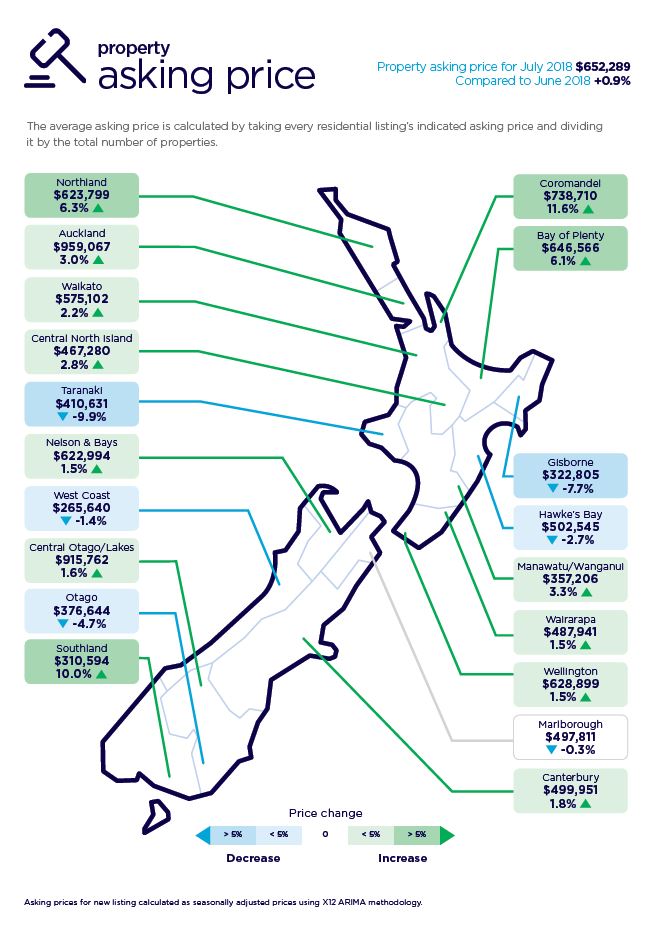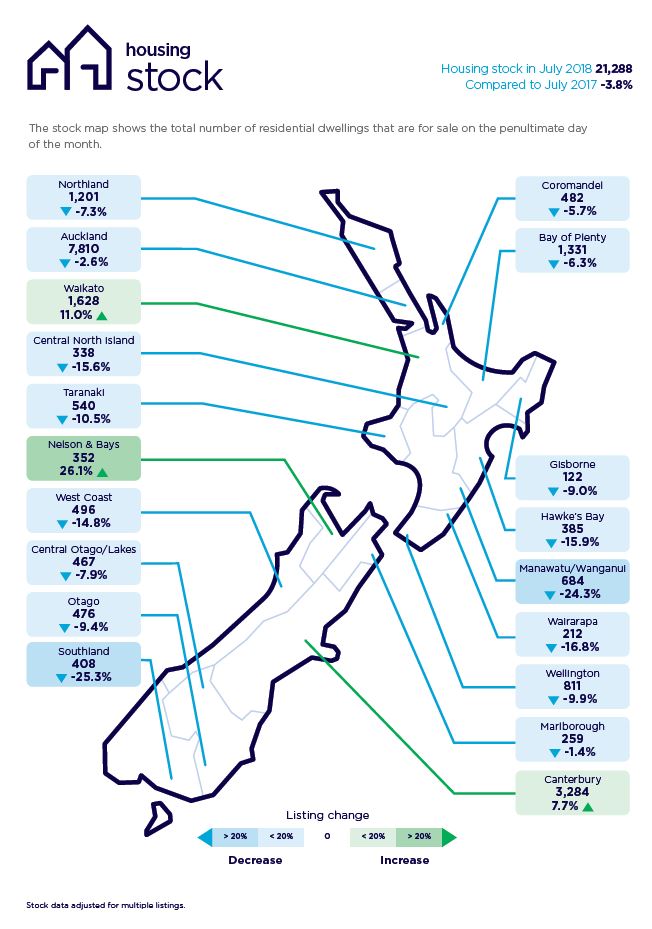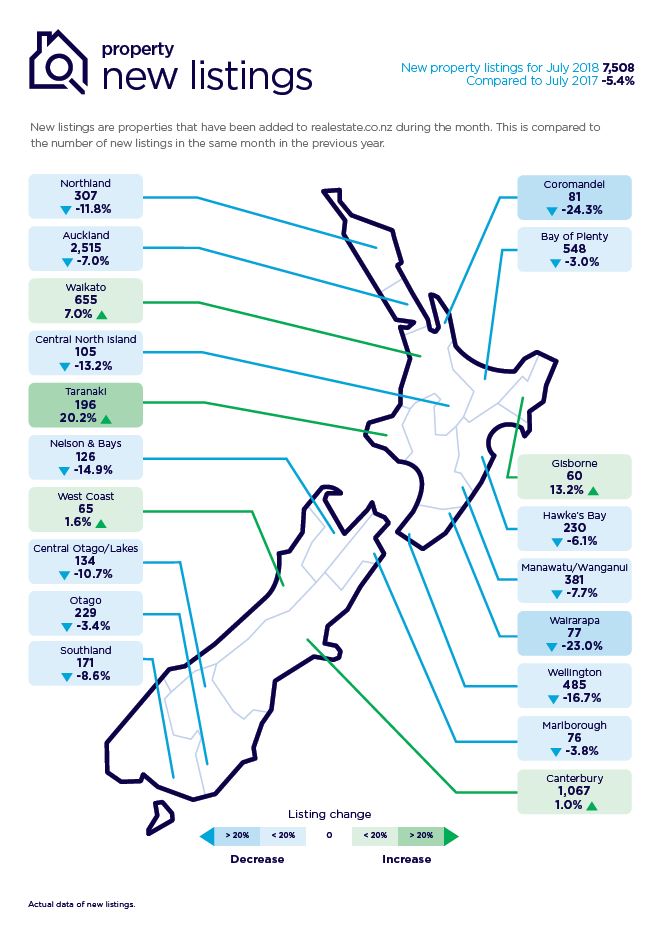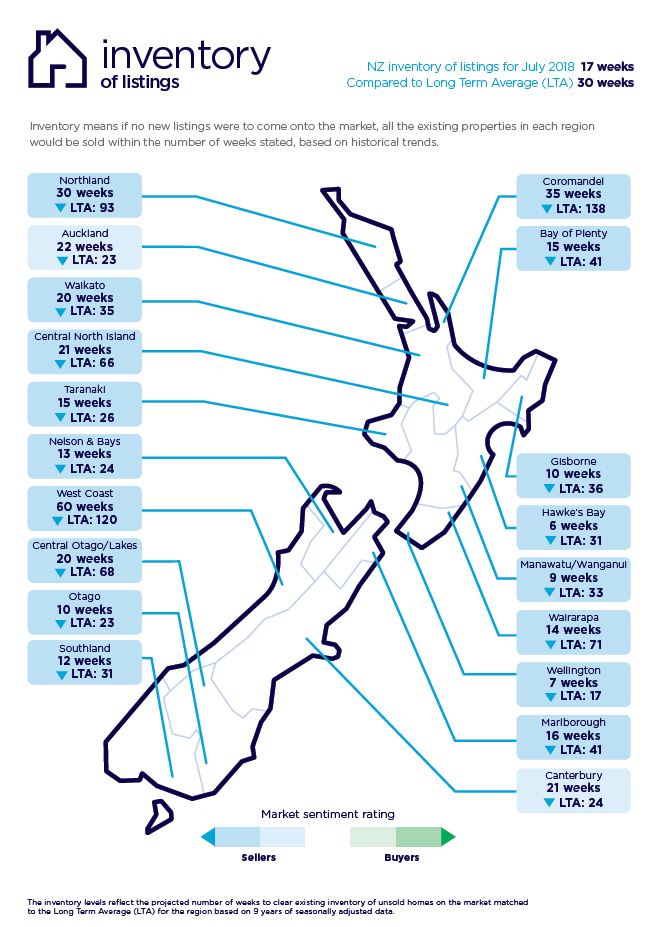Download the New Zealand Property Report as a print-ready PDF.
Interest in homes for sale warms in July | Search for properties back to summertime levels
“Searches for properties in July on realestate.co.nz returned to 2018 summertime levels”, says spokesperson Vanessa Taylor from realestate.co.nz, NZ’s largest property website with the most homes for sale.
Real-time statistics from the site show there were 866,194* unique browsers to the site in July, a nine per cent increase on June 2018.
“Typically, interest in property peaks in the first quarter of the year and then gently declines as we head into winter, before lifting again as we head back into spring.
“June is usually more active than July, as measured by unique users. To see this jump in July is unusual, particularly when it registers numbers equivalent to summer time browsing.
“While it’s yet to be seen whether this translates into an increase in sales, it indicates that Kiwis are still engaged in the housing market,” says Vanessa.

“They may not necessarily be looking to buy or sell their homes right now but are checking out the possible opportunities. These could vary across all forms of housing, depending on where people are at on the property ladder,” she says.
“The significant number of new builds underway, particularly in Auckland, are also a potential factor with a possible flow-on effect to all parts of the market,” she says.
“People looking to buy a brand new home will often be selling their existing house,” says Vanessa.

Total stock down, asking prices up
“While interest in the property market is lively, there were fewer homes to consider,” says Vanessa.
The total number of properties available for sale nationally fell 3.8 per cent (21,288) compared to the same month in 2017. Asking prices increased marginally across the country (0.9 per cent compared to June 2018).
“While this is what could be considered a classic supply and demand situation, there are significant variations across the country so there is no one-size-fits all,” says Vanessa.
“For serious buyers, it could be likened to cherry-picking in a very large orchard,” she says.
In Auckland, the average asking price lifted for the first time in four months. Now sitting at $959,067, it’s comparable to the February 2018 asking price of $961,940.
Record asking prices were registered in six regions in July compared to the previous month. The biggest rise of all-time high regions was registered in Northland, with a 6.3 per cent increase to $623,799. Following close behind Northland was Manawatu/Wanganui (3.3 per cent increase to $357,206) and Waikato (up 2.2 per cent to $575,102.
Wellington, Wairarapa and Nelson & Bays were all up 1.5 per cent ($628,899, $487,941, $622,994 respectively).

New listings down nationally and an all-time low in seven regions
Nationally, new property listings were down 5.4 per cent compared to July 2017, with 7,508 new listings coming onto the market this past month.
Auckland and Wellington recorded significant falls in new listings (7.0 per cent and 16.7 per cent respectively) compared to July last year.
But it was in seven of the 19 regions that the lowest number of new listings in any July month was recorded since realestate.co.nz started collecting data more than 11 years ago.
Coromandel, Wairarapa, Nelson/Bays, Northland, Central Otago/Lakes, Marlborough and Otago all registered record lows.
Of this group, Coromandel registered the biggest fall in new listings compared to the same month the previous year, falling 24.3 per cent (81 listings).
“More significantly, this number has almost halved since January 2018, when we saw 163 new listings, which could represent the difference between a summer and winter market in holiday destinations,” says Vanessa
The Wairarapa region followed Coromandel, with a 23 per cent fall in new listings (77). Nelson/Bays registered a 14.9 per cent fall (126 listings) while Northland dropped by 11.8 per cent with 307 new listings.
Central Otago/Lakes fell 10.7 per cent (134 listings) compared to the previous year, followed by
Marlborough (falling 3.8 per cent with 76 new listings), Otago (falling 3.4 per cent with 229 new listings).

Five regions buck the numbers, with increased new listings led by Taranaki
Five of the 19 regions recorded an increase in the number of new listings in July compared to the same period last year - namely Taranaki which registered a 20.2 per cent increase in new listings (196 homes).
“We need to take into account that Taranaki took a one-off hit in the number of new listings in July 2017, but the region has continued to be a relatively lively market in 2018,” says Vanessa Taylor.
Other regions with a lift in new listings compared to the same month the previous year were: - Gisborne (13.2 per cent increase, 60 listings); Waikato (up seven per cent, 655 listings); West Coast (up 1.6 per cent, 65 listings); and Canterbury (relatively stable at one percent, 1,067).
For media enquiries, please contact:
Liz Holt PPR T: +64 21 042 6590 E: liz.holt@ppr.co.nz
* New Zealanders have an average of 3.2 devices per person. If all persons used their 3.2 devices at different times to search the site, the actual number of New Zealanders on realestate.co.nz would be in the order of 264,631 in July.
Glossary of terms
As the only provider of real estate data in real time, realestate.co.nz offers valuable property market information not available from other sources.
• Average asking price gives an indication of current market sentiment. Statistically, asking prices tend to correlate closely with the sales prices recorded in future months when those properties are sold. As it looks at different data, average asking prices may differ from recorded sales data released at the same time.
• Inventory is a measure of how long it would take, theoretically, to sell the current stock at current average rates of sale if no new properties were to be listed for sale. It provides a measure of the rate of turnover in the market.
• New listings are a record of all the new listings on realestate.co.nz for the relevant calendar month. As realestate.co.nz reflects 97% of all properties listed through registered estate agents in New Zealand, this gives a representative view of the New Zealand property market.
• Demand: the increase or decrease in the number of views per listing in that region, taken over a rolling three-month time frame, compared to the same three-month time frame the previous year – including the current month.
• Seasonal adjustment is a method realestate.co.nz uses to better represent the core underlying trend of the property market in New Zealand. This is done using methodology from the New Zealand Institute of Economic Research.
• Truncated mean is the method realestate.co.nz uses to provide statistically relevant asking prices. The top and bottom 10% of listings in each area are removed before the average is calculated, to prevent exceptional listings from providing false impressions.
01 Aug 2018

